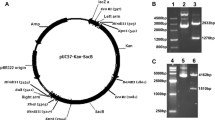Summary
The construction of plasmids which facilitate the study of interplasmidic and intraplasmidic recombination is described. In this system, a single recombination event between two mutated Ter genes on separate plasmids or on one plasmid leads to a change in the host phenotype from sensitivity to resistance to tetracycline.
Recombination proficiencies have been determined for different E. coli K-12 strains: both interplasmidic and intraplasmidic recombination are independent of the recBC gene product. RecA mutations decrease the proficiency of plasmidic recombination 40–100 fold. Intraplasmidic and interplasmidic recombination via the recE pathway are more efficient than via the recBC pathway. Intraplasmidic recombination, but not interplasmidic recombination via the recE pathway is independent of a functional recA product.
Similar content being viewed by others
References
Bachmann BJ (1972) Pedigree of some mutant strains of Escherichia coli K-12. Bacteriol Rev 44:1–56
Barbour SD, Nagaishi H, Templin A, Clark AJ (1970) Biochemical and genetic studies of recombination proficiency in Escherichia coli. II Rec + revertants caused by indirect suppression of Rec - mutations. Proc Natl Acad Sci USA 67:128–135
Bolivar F (1978) Construction and characterization of new cloning vehicles. III Derivatives of plasmid pBR322 carrying unique EcoRI site for selection of EcoRI generated recombinant DNA molecules. Gene 4:121–136
Bolivar F, Rodriguez RL, Green PJ, Betlach MC, Heyneker HL, Boyer HW, Crosa JH, Falkow S (1977) Construction and characterization of new cloning vehicles. II A multi-purpose cloning system. Gene 2:95–113
Brutlag D, Fry K, Nelson T, Hung P (1977) Synthesis of hybrid bacterial plasmids containing highly repeated satellite DNA. Cell 10:509–519
Clark AJ (1973) Recombination deficient mutants of E. coli and other bacteria. Annu Rev Genet 7:67–86
Clark AJ (1974) Progress toward a metabolic interpretation of genetic recombination of Escherichia coli and bacteriophage Lambda. Genetics 78:259–271
Cohen A, Ram D, Halvorson HO, Wensink PC (1978) Deletions within E. coli plasmids carrying yeast rDNA. Gene 3:135–147
Cramer JH, Farrelly FW, Barnitz JT, Rownd RH (1977) Construction and restriction endonuclease mapping of hybrid plasmids containing S. cerevisia ribosomal DNA. Mol Gen Genet 151:229–244
Gillen J, Clark AJ (1974) The recE pathway of bacterial recombination. In: Grell RF (ed) Mechanism in recombination. Plenum Press, New York, pp 123–136
Gillen JR, Karu AE, Nagaishi H, Clark AJ (1977) Characterization of deoxyribonuclease determined by lambda reverse as exonuclease VIII of Escherichia coli. J Mol Biol 113:27–41
Gillen JR, Willis DK, Clark AJ (1981) Genetic analysis of the recE pathway of genetic recombination in Escherichia coli K-12. J Bacteriol 145:521–532
Goldmark PJ, Linn S (1970) An endonuclease activity from Escherichia coli absent from certain rec strains. Proc Natl Acad Sci USA 67:434–444
Honigman A, Oppenheim AB, Hohn B, Hohn T (1981) Plasmid vector for positive selection of DNA inserts controlled by the λP promotor, repressor and antitermination function. Gene 13:301–310
Kato AC, Bartok MJ, Frazer MJ, Denhart DT (1973) Sensitivity of superhelical DNA to a single-strand specific endonuclease. Biochim Biophys Acta 308:68–78
Khachatourians GG, Paterson MC, Sheehy RJ, Dorp BV, Worthy TE (1975) DNA degradation in minicells of Escherichia coli K-12. II Effect of recA and recB21 mutations on DNA degradation in minicells and detections of exonuclease-V activity. Mol Gen Genet 138:179–192
Kushner SR, Nagaishi H, Clark AJ (1972) Indirect suppression of recB and recC mutations by exonuclease I deficiency. Proc Natl Acad Sci USA 69:1366–1370
Lam ST, Stahl MM, McMilin KD, Stahl, FW (1974) Rec mediated recombinational hot spot activity in bacteriophage lambda. II A mutation which causes hot spot activity. Genetics 77:425–433
Lennox ES (1955) Transduction of linked genetic characters of the host by bacteriophage P1. Virology 1:190–206
McEntee K, Weinstock GM, Lehman IR (1979) Initiation of general recombination catalyzed in vitro by the recA protein of Escherichia coli. Proc Natl Acad Sci USA 76:2615–2619
McMilin KD, Stahl MM, Stahl FW (1974) Rec-mediated recombinational hot spot activity in bacteriophage lambda. I. Hot spot activity associated with spi - deletion and bio substitution. Genetics 77:409–425
Marsden HS, Pollard EC, Ginoza W, Randall EP (1974) Involvement of recA and exr genes in the in vivo inhibition of recBC nuclease. J Bacteriol 118:465–470
Metzer E, Levitz R, Halpern YS (1979) Isolation and properties of Escherichia coli K-12 mutants impaired in the utilization of γ-aminobutyrate. J. Bacteriol 137:1111–1118
Mount DW (1971) Isolation and genetic analysis of a strain of Escherichia coli K-12 with an amber recA mutation. J Bacteriol 107:388–389
Shibata T, Dasgupta RP, Cunningham RP, Radding CM (1979) Purified Escherichia coli recA protein catalyzes homologous pairing of superhelical DNA and single-stranded fragments. Proc Natl Acad Sci USA 76:1638–1642
Stahl FW (1979) Genetic recombination, thinking about it in phage and fungi. W.H. Freeman and Co, San Francisco, p 204
Stahl FW, McMilin KD, Stahl MM, Grosemann JM, Lam S (1974) The distribution of crossovers along unreplicated lambda bacteriophage chromosomes. Genetics 77:395–408
Stahl FW, Stahl MM (1977) Recombination pathway specificity of Chi. Genetics 86:715–725
Sugino A, Goodman HM, Heyneker HL, Shiner J, Boyer HW, Cosserelli N (1977) Interaction of bacteriophage T4 RNA and DNA ligases in joining of duplex DNA at base-paired ends. J Biol Chem 252:3987–3994
Sutcliffe JG (1978) pBR322 restriction map derived from the DNA sequence: accurate DNA size markers up to 4361 nucleotide pairs long. Nucleic Acid Res 5:2721–2728
Taylor A, Smith GR (1980) Unwinding of DNA by the recBC enzyme. Cell 22:447–457
Weintraub H, Groudine M (1976) Chromosomal subunits in active genes have an altered conformation. Science 193:848–856
Zieg J, Kushner SR (1977) Analysis of genetic recombination between two partially deleted lactose operons of Escherichia coli K-12 J Bacteriol 131:123–132
Zissler JE, Singer E, Shaeffer F (1971) The role of recombination in growth of bacteriophage lambda. I. The gamma gene. In: Hershey AD (ed) The bacteriophage lambda. Cold Spring Harbor Laboratory, Cold Spring Harbor, New York, pp 455–468
Author information
Authors and Affiliations
Additional information
Communicated by F.W. Stahl
Rights and permissions
About this article
Cite this article
Laban, A., Cohen, A. Interplasmidic and intraplasmidic recombination in Escherichia coli K-12. Molec. Gen. Genet. 184, 200–207 (1981). https://doi.org/10.1007/BF00272905
Received:
Issue Date:
DOI: https://doi.org/10.1007/BF00272905




